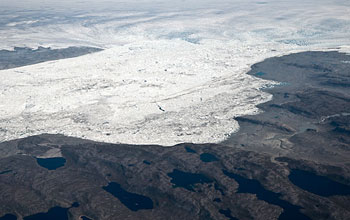Multimedia Gallery
Jakobshavn Isfjord (ice fjord)--the largest outlet glacier on Greenland's West Coast.
The north branch of Jakobshavn Isbrae is in the upper left corner of the image, with several newly calved icebergs in front of it. The larger, faster moving, south branch is located near the upper right corner. Prior to about 2003, both branches merged to create a large floating ice tongue that extended beyond the iceberg covered area visible in this image. Since the 1990, the glacier calving front (terminus) has retreated about 18 km (11 miles). Now, it is only in the winter that both branches sometimes merge to form a much smaller seasonal ice tongue, which breaks up in the spring.
Credit: Polar Science Center, Applied Physics Laboratory, University of Washington
Images credited to the National Science Foundation, a federal agency, are in the public domain. The images were created by employees of the United States Government as part of their official duties or prepared by contractors as "works for hire" for NSF. You may freely use NSF-credited images and, at your discretion, credit NSF with a "Courtesy: National Science Foundation" notation.
Additional information about general usage can be found in Conditions.
Also Available:
Download the high-resolution JPG version of the image. (178 KB)
Use your mouse to right-click (Mac users may need to Ctrl-click) the link above and choose the option that will save the file or target to your computer.
Related story: Analysis of Speed of Greenland Glaciers Gives New Insight for Rising Sea Level



